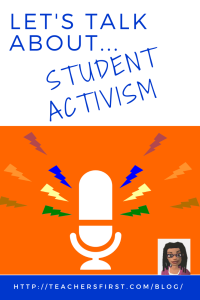Reflecting on the anniversary of Bloody Sunday, I’ve wondered what we as a society have learned and how those lessons can help our students today. Listening to some of the youngest participants in the march – children at the time – reminds me that our children need to see that they can “drive the change that they want to see in the world.” It’s a theme we’ve been studying in the TeachersFirst book study on Teach Boldly: Using Edtech for Social Good.
The text gives us a simple recipe for inspiring students to take action:
- Introduce them to the Universal Declaration of Human Rights or the Sustainable Development Goals.
- Spend time with your students discussing the issues that come up as dear to them and help them problem-solve how they can make an impact.
- Introduce them to students in other locales who might have the issue under discussion or are also interested in working to solve the problem.
- Give them tools to research and present the stories that will move others to action.
Introduce Child Activists
One way for students to learn about activism is to research student activists. Many can be found as you study historical events such as Bloody Sunday. One place to find primary source materials to introduce the topic is the Library of Congress. Their Civil Rights History Project Collection has several examples of youth activism. Outside of a historical context, current student activists can also serve as examples.
- Lynda Blackmon Lowery wrote about her experiences working with voting rights activists in the 1960s in her book Turning 15 on the Road to Freedom. You can introduce the text using the TeachersFirst Reading Trek.
- Barbara Johns led a school walkout to challenge school funding practices. Scholastic offers a free lesson on her activism and its results. Some even consider Johns’ strike the start of the student-led civil rights movement.
- As a third grader in 2013, Asean Johnson took on school closures in his Chicago neighborhood, leading to him being the youngest speaker at the 50th anniversary of the March on Washington.
- Eleven-year-old Naomi Wadler led a student walkout at her elementary school over gun violence in 2018. It was part of a movement of student walkouts to honor the victims of a shooting in Parkland, Florida. She became the youngest to speak at the student-led March for our Lives later that year.
Additional Ideas and Resources
You may be looking for a more structured way to introduce student activism. Here are a few ideas and resources.
- Girl Rising (reviewed here) provides curricular materials on becoming a changemaker, educational equity, and social justice.
- Teach for America offers a primer on youth activism, including ideas and solutions for navigating pushback and nurturing civic engagement.
- PBS LearningMedia shares this lesson on student activism and social justice.
- Pennies for Peace (reviewed here) created a free toolkit that covers themes such as global citizenship, the power of education, and humanitarian efforts.
Students want to be heard and be part of shaping the future. While many of the issues they are trying to influence are the same, these students use new and different methods. However, they need mentorship and modeling to clarify and amplify their message. Do you have plans to help your students make their voices heard? Let us know in the comments below.


